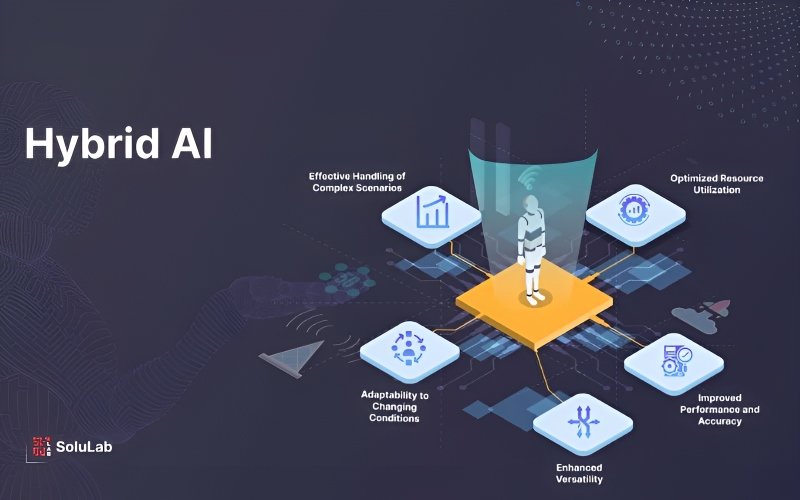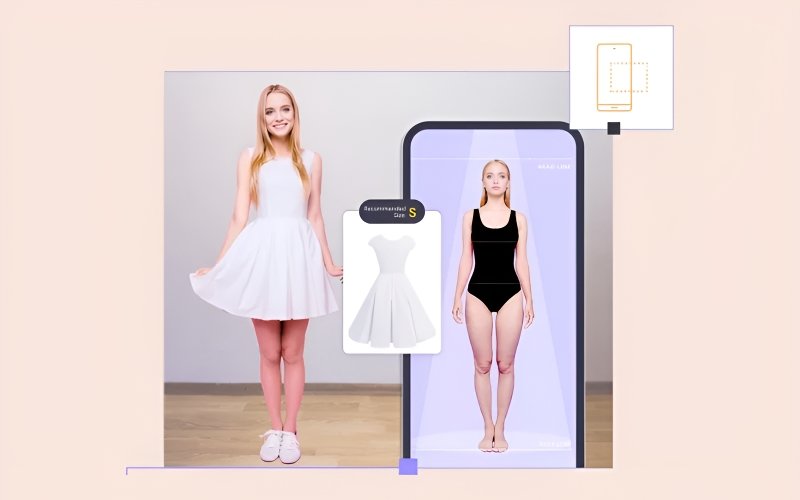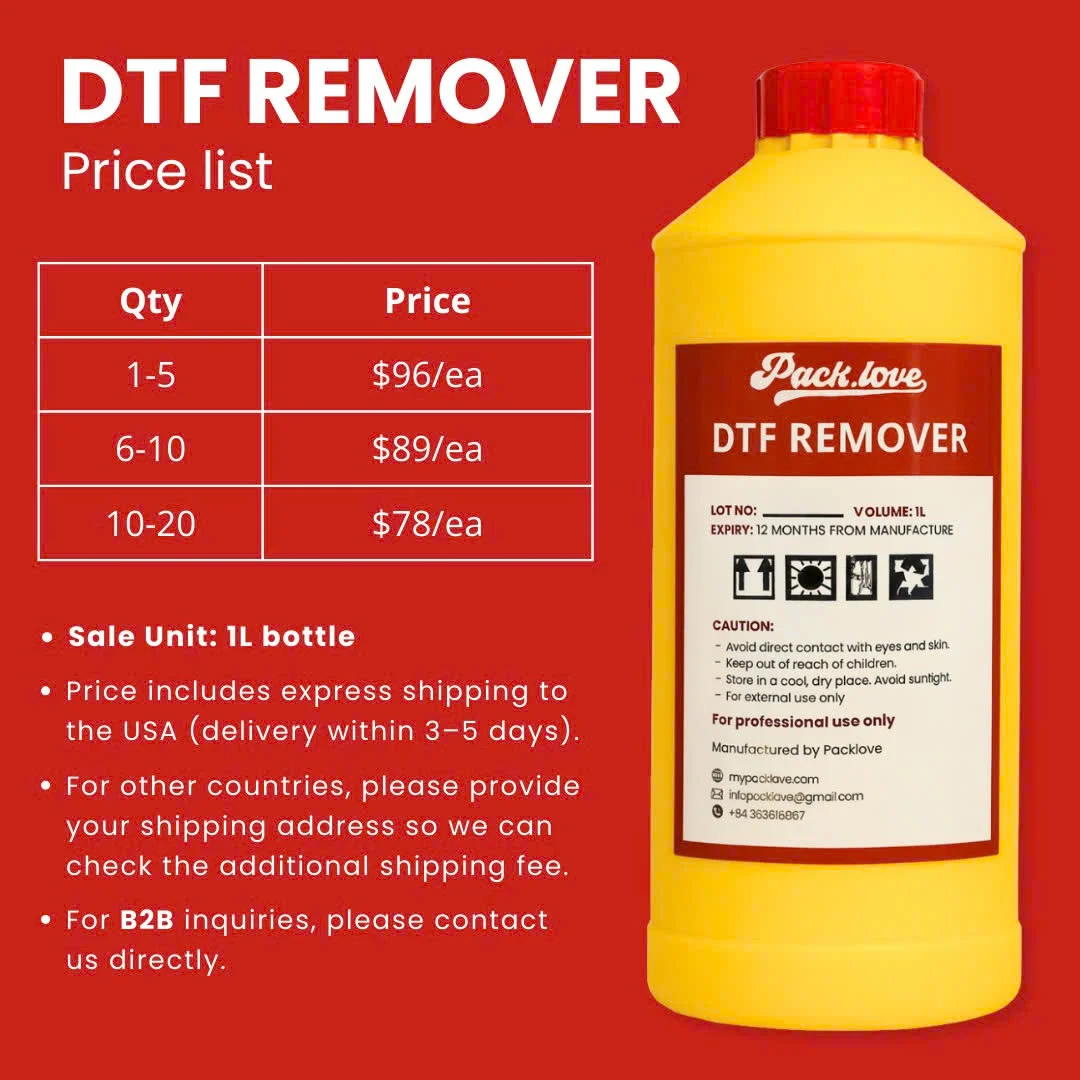AI Clothing Size Prediction: Boost Sales and Cut Returns
In the fast-paced world of online clothing retail, sizing issues stand as a significant obstacle, leading to a cascade of problems for businesses. High return rates, increased shipping expenses, frustrated customers, and potential damage to brand reputation are just some of the consequences stemming from inaccurate size predictions. For small to medium-sized online clothing businesses, particularly those targeting the demanding US market, these challenges can severely impact profitability and long-term success.
This article delves into the transformative potential of AI clothing size prediction, offering a beacon of hope for businesses grappling with these issues. By understanding how AI is revolutionizing size recommendations, you will gain valuable insights into reducing returns, boosting sales, and cultivating happier, more loyal customers. We will explore the workings of this technology, examine leading platforms, and provide expert advice to guide you in leveraging AI to gain a competitive edge and enhance your online clothing business. Discover how to navigate the future of fashion retail and create a seamless, satisfying shopping experience for your customers.
1. Revolutionizing online retail: understanding AI clothing size prediction
Imagine this scenario: a customer excitedly anticipates the arrival of a new shirt ordered online, only to be met with disappointment when it doesn’t fit. This all-too-common experience highlights a major pain point in the online clothing industry: inaccurate sizing.
But what if technology could step in to significantly reduce these sizing mishaps, leading to happier customers and a more efficient business for you? This is the promise of AI clothing size prediction – a rapidly evolving field poised to transform how we shop for clothes online.
As e-commerce continues its upward trajectory in the fashion world, adopting innovative solutions like AI size prediction is becoming less of a luxury and more of a necessity for staying competitive and customer-centric.
1.1. The growing problem of sizing inaccuracy in online fashion
The issue of incorrect sizing in online fashion is more than just a minor inconvenience; it’s a significant drain on resources and customer satisfaction. Consider the numbers: a substantial portion of online clothing returns – some studies suggest it can be as high as 30-50% – are attributed to sizing problems.
These returns are costly. Beyond the direct expense of return shipping and processing, there are hidden costs like inventory management complexities, potential damage to returned items, and the labor involved in handling these returns.
Furthermore, sizing discrepancies breed customer frustration. Receiving an ill-fitting garment is disappointing, leading to negative shopping experiences. Traditional size charts, while intended to be helpful, often fall short in the online context.
Body shapes and personal fit preferences vary greatly, and a static chart simply cannot account for these nuances. This inadequacy of traditional methods in the dynamic online environment underscores the growing challenges of apparel sizing in e-commerce. For online clothing businesses, especially those striving for growth in competitive markets, tackling these sizing issues head-on is crucial for sustainable success.

1.2. What exactly is AI clothing size prediction?
At its core, AI clothing size prediction is a smart technological solution designed to determine the most likely correct clothing size for an online shopper. Think of it as a sophisticated digital assistant that analyzes various pieces of information to make an educated guess about fit. This isn’t just about replacing size charts with another chart; it’s about leveraging the power of algorithms and data.
These AI systems work by processing a range of data points. This can include a customer’s past purchase history, their stated size preferences for different clothing categories, and even browsing behavior on your website.
Underlying this technology are sophisticated techniques like machine learning and neural networks. While these terms might sound complex, the basic idea is that the AI learns from vast amounts of data to identify patterns and relationships between customer characteristics and clothing sizes.
By analyzing this data, the AI can then predict, with a high degree of accuracy, the optimal size for a particular customer for a specific garment. This predictive capability is what sets AI size prediction apart, offering a far more personalized and effective approach to solving the persistent problem of sizing in online fashion retail.
2. How AI predicts your perfect fit: Decoding the technology
So, how does AI actually work its magic to predict your ideal clothing size? While the inner workings can be quite intricate, the fundamental process is surprisingly understandable. Think of AI size prediction as a smart detective, piecing together clues to solve the puzzle of finding the right fit for each customer.
These clues come in the form of data, and the detective’s toolkit consists of powerful algorithms and various technological approaches. Let’s break down some of the key methods AI systems employ to deliver those remarkably accurate size recommendations.
2.1. The power of algorithms: Analyzing data for size recommendations
At the heart of AI size prediction lies the power of algorithms. These are essentially sets of instructions that enable computers to process information and make decisions – in this case, size recommendations. The magic happens when these algorithms are fed with vast amounts of data.
Imagine an AI system sifting through mountains of customer information: past purchase history, items browsed, explicitly stated size preferences, and even demographic details. By analyzing this data, the algorithms begin to identify patterns. For example, they might learn that customers who previously bought size M shirts and size 30 jeans are highly likely to need a size M in a new style of t-shirt.
Beyond structured data, some sophisticated AI systems also utilize Natural Language Processing (NLP). NLP allows the AI to understand and interpret human language. This is incredibly useful for analyzing product descriptions and customer reviews. For instance, the AI can scan reviews mentioning “runs small” or “true to size” for a particular garment, incorporating this valuable fit feedback into its size predictions.
Another technique often employed is clustering. This involves grouping customers with similar characteristics and purchase behaviors together. By identifying these clusters, the AI can make more informed predictions. If a new customer falls into a cluster of individuals who typically wear size L, the AI can confidently recommend size L for them as well.
Ultimately, it’s this intelligent analysis of diverse data points through algorithms that empowers AI to provide personalized and data-driven size recommendations.

2.2. Hybrid approaches: Combining AI with body measurement technologies
While data analysis alone is powerful, some AI size prediction systems take accuracy a step further by incorporating body measurement technologies. These hybrid approaches combine the strengths of AI algorithms with precise body data, offering an even more refined size recommendation. This is where technologies like body measurement apps and virtual try-on tools come into play.
Imagine a customer using a smartphone app to quickly scan their body or input a few key measurements. This data is then fed into the AI system, providing a direct and objective assessment of the customer’s physique.
By combining this body measurement data with the previously mentioned data analysis techniques, the AI gains a much richer understanding of the customer’s size profile. This leads to significantly improved accuracy, especially for garments where precise fit is crucial.
The methods for body measurement can vary. Some apps utilize the phone’s camera and computer vision to create a 3D model of the body, while others rely on manual input of measurements like chest, waist, and hip circumference.
Regardless of the specific method, the integration of body measurement data into AI size prediction represents a significant advancement, pushing the boundaries of accuracy and personalization in online clothing shopping.

3. Benefits you can’t ignore: Why AI size prediction is a game-changer for clothing brands
Implementing AI size prediction isn’t just about keeping up with the latest tech trends; it’s about making smart, strategic moves that directly impact your bottom line and brand reputation. The advantages extend far beyond simply reducing returns – although that’s a significant win in itself.
By embracing this technology, clothing brands can unlock a cascade of positive outcomes, from increased sales and happier customers to valuable data insights and even a more sustainable business model. Let’s explore the key benefits that make AI size prediction a true game-changer in the competitive world of online fashion.
3.1. Boosting your bottom line: Increased sales and reduced return rates
The most immediate and tangible benefit of AI size prediction is its direct impact on profitability. Think about it: when customers are confident they’re choosing the right size, they are more likely to complete their purchase.
This improved shopping experience translates directly into higher conversion rates – meaning more browsers become buyers. Furthermore, by minimizing sizing errors, AI significantly reduces the dreaded return rates. Fewer returns mean less money spent on reverse logistics, restocking, and processing. These savings quickly add up, directly boosting your ROI and strengthening your bottom line.
Consider this: some brands implementing AI size prediction have reported reductions in return rates related to sizing by as much as 20-40%. Imagine the impact of reclaiming that percentage of revenue and reinvesting it back into your business! Beyond the cost savings, reduced returns also free up valuable inventory and streamline operations, allowing you to focus on growth and other strategic initiatives.
In the competitive e-commerce landscape, where every percentage point matters, the financial advantages of AI size prediction are simply too significant to ignore.

3.2 Happy customers, loyal brands: Enhancing customer satisfaction and brand loyalty
Beyond the numbers, AI size prediction cultivates a more positive and satisfying customer experience. Imagine the delight of a customer who receives their online order and finds that everything fits perfectly, the first time. This positive experience is a powerful driver of customer satisfaction.
When shoppers consistently find the right fit thanks to accurate size recommendations, they are far more likely to become repeat customers. They develop trust in your brand and are more inclined to make future purchases.
Happy customers are also more likely to leave positive reviews and recommend your brand to others. This word-of-mouth marketing is invaluable in building a strong brand image and attracting new customers. In essence, AI size prediction contributes to a virtuous cycle: accurate sizing leads to satisfied customers, satisfied customers become loyal customers, and loyal customers become brand advocates.
This enhanced customer experience and strengthened brand loyalty are crucial assets for long-term success in the online fashion industry.
3.3. Data-driven decisions: Gaining valuable insights into your customer base
Implementing AI size prediction isn’t just about improving the shopping experience; it also unlocks a treasure trove of valuable data insights about your customer base. AI systems continuously collect data on customer preferences, sizing patterns, and purchase behavior. This data is far more than just numbers; it’s a window into understanding your customers on a deeper level.
For example, you can analyze aggregated data to identify sizing trends for specific garment types or customer demographics. This information can be invaluable for product development. Perhaps you discover that a particular style consistently runs small for a certain customer segment.
Armed with this insight, you can adjust future designs and size charts to better cater to your target audience. Furthermore, this data can inform inventory management, ensuring you stock the right sizes in the right quantities.
It can also be used to personalize marketing efforts, tailoring recommendations and promotions based on individual customer size profiles and preferences. By leveraging the data generated by AI size prediction, you can move from guesswork to data-driven decisions across various aspects of your business, leading to greater efficiency and effectiveness.
3.4. Going green: Contributing to sustainability in fashion
In today’s environmentally conscious world, sustainability is no longer a niche concern but a core value for many consumers. AI size prediction can contribute to your brand’s sustainability efforts in a significant way. By drastically reducing return rates, you are also reducing the environmental impact associated with returns. Fewer returns mean less packaging waste, less fuel consumed in return shipping, and a lower carbon footprint overall.
The fashion industry is often criticized for its environmental impact, and returns are a significant contributor to this. By embracing AI size prediction, you are taking a concrete step towards more responsible retail practices.
This commitment to sustainability can resonate with environmentally conscious customers and enhance your brand image as an eco-friendly and responsible business. In a market increasingly driven by ethical considerations, the sustainability benefits of AI size prediction offer a compelling advantage, aligning your business goals with broader environmental responsibility.

4. Choosing the right AI partner: Exploring leading platforms and technologies
Now that you understand the power and benefits of AI size prediction, the next logical step is to explore the available solutions. The market offers a variety of platforms and technologies, each with its own strengths, features, and target audience.
Choosing the right AI partner is a crucial decision that will significantly impact the success of your implementation. To help you navigate this landscape, we’ll take a closer look at some of the prominent players in the field.
These platforms offer diverse approaches to AI size prediction, catering to different business needs and technical requirements. By understanding what each platform brings to the table, you can make a more informed decision and select the AI solution that best aligns with your brand and your customers.
4.1. Easysize: fit quiz for seamless Shopify integration
For businesses operating on the Shopify platform, Easysize presents itself as a particularly appealing option, known for its seamless integration and user-friendly approach. Easysize primarily utilizes a “Fit Quiz” format.
This interactive quiz guides shoppers through a series of simple questions about their body measurements, usual clothing sizes, and fit preferences. Based on their responses, Easysize provides a size recommendation tailored to the specific garment they are viewing.
A key advantage of Easysize is its deep integration with Shopify. This makes implementation straightforward and hassle-free for Shopify store owners. Beyond ease of use, Easysize also boasts robust features, including support for various size formats (crucial for international markets), customization options to align the quiz with your brand’s look and feel, and language localization to cater to diverse customer bases.
Many businesses using Easysize have reported tangible results, including increases in sales conversion rates and a noticeable reduction in size-related returns. If you’re seeking a Shopify-centric solution that’s easy to implement and focused on a user-friendly quiz experience, Easysize is definitely worth considering.

4.2. Sizer: AI-powered body measurement for precise recommendations
Sizer takes a different approach, placing a strong emphasis on precise body measurement as the foundation for its AI size recommendations. Instead of relying solely on questionnaires or past purchase data, Sizer leverages AI-powered body measurement technology.
This technology allows customers to obtain accurate body measurements using their smartphone camera. By scanning their body with their phone, customers can generate precise data that Sizer’s AI algorithms then use to determine the optimal clothing size.
This focus on body measurement makes Sizer particularly well-suited for businesses where accurate fit is paramount, such as in the fashion industry, but also in sectors like uniform manufacturing and even tailoring businesses.
The precision offered by body measurement data can lead to a significant reduction in unwanted returns, especially for garments where fit is critical. Sizer’s technology is designed to be versatile, supporting omnichannel fashion experiences and catering to businesses that require highly accurate size recommendations based on objective body data. If accuracy through body measurement is a top priority for your brand, Sizer offers a compelling solution.

4.3. Fitle: hybrid algorithms and extensive size guide database
Fitle distinguishes itself through its sophisticated hybrid algorithms and a vast database of size information. Their technology combines various AI techniques, including Natural Language Processing (NLP), neural networks, and clustering, to deliver highly accurate size recommendations. Fitle’s algorithms are designed to understand not just size charts, but also garment morphology – how different fabrics and styles fit on the body.
A key differentiator for Fitle is its extensive database. This database includes 3D scanned individuals, providing a rich source of body data, and a comprehensive collection of brand size guides. By drawing upon this vast knowledge base and employing advanced AI techniques, Fitle aims to provide exceptionally accurate size recommendations.
Their approach is particularly beneficial for brands seeking a solution that goes beyond basic size chart matching and truly understands the nuances of garment fit. If you prioritize cutting-edge AI technology and a deep understanding of garment morphology for superior accuracy, Fitle is a platform to explore.
4.4. True Fit: personalized fit recommendations across a vast network
True Fit stands out due to its focus on personalization and its expansive network of brands and retailers. They have built a vast “Fit Genome,” which is essentially a massive database of fit data from millions of shoppers and thousands of brands.
True Fit leverages this data-driven approach to provide highly personalized fit recommendations. When a shopper interacts with True Fit, they are tapping into this extensive network and benefiting from the collective fit knowledge accumulated over time.
True Fit’s strength lies in its ability to deliver personalized shopping experiences at scale. By integrating with a wide range of brands and retailers, they can provide consistent and accurate size recommendations across different shopping destinations.
This focus on personalization and network effects makes True Fit a valuable partner for brands looking to enhance customer experience and improve conversion rates across a broad retail landscape. If you value personalization, data-driven insights from a large network, and improved conversion across multiple retail channels, True Fit is a platform to consider.

4.5. Fit Analytics: AI Size Advisor for global e-commerce
Fit Analytics positions itself as an experienced provider of AI Size Advisor solutions, particularly for global e-commerce businesses. They emphasize their long-standing experience in the field and their partnerships with major international brands. Fit Analytics’ AI-powered recommendations are designed to be robust and scalable, catering to the demands of large-scale online retailers operating in diverse markets.
A key focus for Fit Analytics is on demonstrably reducing returns. They highlight the impact of their AI Size Advisor on improving fit accuracy and minimizing size-related returns for their brand partners. With a proven track record and a focus on global e-commerce, Fit Analytics offers a reliable and experienced solution for businesses seeking a partner with a strong track record in AI size prediction. If you prioritize experience, a focus on return reduction, and a solution tailored for global e-commerce operations, Fit Analytics is a platform to investigate.
5. Expert advice: Key considerations before implementing AI size prediction
Embarking on the journey of AI size prediction can be incredibly rewarding, but like any strategic technology adoption, careful planning and consideration are essential. Before you integrate an AI solution into your e-commerce platform, there are several key factors to keep in mind.
Drawing upon years of experience in the garment industry and observing the evolution of fashion tech, we’ve compiled some expert advice to guide you through the implementation process. These considerations range from customization and seamless integration to data privacy and ongoing performance monitoring.
By addressing these aspects proactively, you can maximize the benefits of AI size prediction and ensure a successful and impactful implementation for your online clothing business.
5.1. Customization is key: Tailoring AI to your brand and products
One size does not fit all, especially when it comes to AI size prediction. Generic solutions may offer a baseline level of accuracy, but to truly maximize the benefits for your brand, customization is paramount. Every clothing brand has its unique sizing standards, target customer demographics, and product styles. Therefore, it’s crucial to seek out AI platforms that offer customization options, allowing you to tailor the technology to your specific needs.
When evaluating AI solutions, inquire about the level of customization available. Can you customize the questions asked in a Fit Quiz to better reflect your brand’s sizing philosophy? Can you fine-tune the underlying logic of the AI algorithms based on your historical sales data and fit feedback?
Ideally, the platform should allow you to incorporate brand-specific data, such as your unique size charts and garment specifications, to improve accuracy. Remember, the more you can tailor the AI to your brand and products, the more precise and effective the size recommendations will be for your customers.
5.2. Seamless integration: Ensuring compatibility with your e-commerce platform
A smooth and seamless integration with your existing e-commerce platform is crucial for a successful AI implementation. Imagine a clunky, poorly integrated size prediction tool that disrupts the customer journey and slows down the shopping experience.
This would be counterproductive and could even deter customers. Therefore, prioritize AI solutions that offer seamless integration with your platform, whether it’s Shopify, Magento, or another e-commerce system.
Before committing to a platform, thoroughly investigate the integration process. Does the AI provider offer pre-built apps or plugins for your platform, like Easysize’s Shopify integration? Is there robust API documentation available for custom integration if needed?
Understand the technical requirements and ensure your team has the resources to handle the integration process. A seamless integration translates to a smoother customer experience, faster implementation, and reduced technical headaches down the line.

5.3. Data privacy and transparency: Building customer trust
In today’s digital landscape, data privacy is a paramount concern for consumers. When implementing AI size prediction, you are handling customer data, including potentially sensitive information like body measurements or size preferences. It’s crucial to prioritize data privacy and transparency to build and maintain customer trust.
Be upfront and transparent with your customers about how their data is being used for size prediction. Clearly outline your data privacy policies and assure customers that their information is handled securely. Choose AI platforms that are compliant with relevant data privacy regulations, such as GDPR (General Data Protection Regulation) or CCPA (California Consumer Privacy Act).
Demonstrating a commitment to ethical data handling and transparency is not just a legal requirement; it’s essential for building long-term customer relationships and fostering a trustworthy brand image.

5.4. Accuracy and continuous improvement: Monitoring and optimizing AI performance
While AI size prediction has made remarkable strides, it’s important to have realistic expectations about accuracy. No AI system is perfect, and occasional sizing errors may still occur. However, the key is to choose a platform that prioritizes accuracy and is committed to continuous improvement.
Once you’ve implemented an AI solution, don’t consider it a “set-it-and-forget-it” endeavor. Actively monitor its performance. Track return rates, gather customer feedback on size accuracy, and analyze the data provided by the AI platform itself.
Choose a provider that offers ongoing algorithm updates and improvements based on real-world data and user feedback. The AI field is constantly evolving, and a platform that embraces continuous improvement will ensure that your size prediction technology remains accurate and effective over time. Regular monitoring and optimization are essential for maximizing the long-term ROI of your AI investment.
6. FAQs about AI clothing size prediction
6.1. How accurate is AI clothing size prediction?
Accuracy is generally high and improving, often reaching 80-90%, but varies by platform and clothing type. Avoid expecting perfection, but anticipate significantly fewer sizing errors than with traditional methods.
6.2. Is AI size prediction expensive to implement?
Costs vary by platform and features, with subscription or usage-based pricing models. Consider the ROI from reduced returns and increased sales, which can often offset the investment.
6.3. What kind of data is needed for AI size prediction to work?
Data includes purchase history, browsing behavior, and size preferences; some systems optionally use body measurements for greater accuracy. More data generally leads to better predictions.
6.4. Can AI size prediction work for all types of clothing?
Yes, generally, but accuracy may vary; some platforms specialize in specific categories. Performance is typically better for standardized garments compared to complex styles.
6.5. How easy is it to integrate AI size prediction into my existing online store?
Ease depends on the platform and your e-commerce system; many offer seamless integrations with platforms like Shopify. APIs are available for custom integrations, but check for platform compatibility and support.
7. Packlove – enhancing your brand experience beyond perfect fit
While AI size prediction solves the crucial aspect of fit in online clothing retail, remember that a truly exceptional brand experience encompasses more than just the garment itself. The moment a customer receives their order is a key opportunity to reinforce your brand’s quality and attention to detail.
This is where Packlove steps in. With over 8 years of expertise in the garment industry, we specialize in providing premium labels, tags, zipper bags, and poly mailers that elevate your brand presentation. Think of it this way: accurate sizing ensures customer satisfaction with the product, and high-quality packaging from Packlove enhances their perception of your brand as a whole, creating a cohesive and positive impression from purchase to delivery.
By implementing AI size prediction and potentially reducing return-related costs, you can strategically reinvest in enhancing your packaging. Choosing custom-designed labels, durable zipper bags, or branded poly mailers from Packlove adds a touch of sophistication and reinforces the value of your clothing.
This investment in premium packaging, combined with the perfect fit ensured by AI, creates a memorable unboxing experience and strengthens customer loyalty. Explore our range of garment packaging solutions at mypacklove.com and discover how we can help you create a truly exceptional brand experience. Contact us today for a personalized consultation.
Visit our website at https://mypacklove.com/ or contact us [email protected] to explore our options and contact us for a free consultation.
Read more:
In conclusion, AI clothing size prediction is far more than just a fleeting trend; it represents a fundamental shift in online fashion retail. By tackling the persistent problem of sizing inaccuracy, AI offers a powerful solution to reduce returns, boost sales, and cultivate happier, more loyal customers.
As we look to the future of fashion, personalized shopping experiences driven by intelligent technologies like AI will become increasingly crucial for success. For online clothing businesses aiming to thrive in a competitive market, embracing AI size prediction is not just an upgrade, but a strategic imperative to enhance customer satisfaction, optimize operations, and secure a competitive edge in the evolving landscape of e-commerce.























